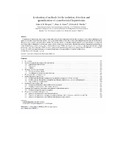| dc.contributor.author | Msagati, T.A.M. | |
| dc.contributor.author | Siame, B.A. | |
| dc.contributor.author | Shushu, D.D. | |
| dc.date.accessioned | 2008-09-18T10:49:07Z | |
| dc.date.available | 2008-09-18T10:49:07Z | |
| dc.date.issued | 2006 | |
| dc.identifier.citation | Msagati, T.A.M. et al (2006) Evaluation of methods for the isolation, detection and quantification of cyanobacterial hepatotoxins, Aquatic Toxicology, Vol. 78, No. 4, pp. 382-397 | en |
| dc.identifier.issn | 0166-445X | |
| dc.identifier.uri | http://hdl.handle.net/10311/218 | |
| dc.description.abstract | Cyanobacterial hepatotoxins such as microcystins and nodularins have been responsible for the poisoning of both animals and humans who
ingest or come into contact with toxic blooms. They are extremely stable in water due to their stable chemical structure and can tolerate radical
changes in water chemistry, including pH and salinity. Different methods for the extraction and detection of these compounds have been reported.
Extraction methods utilizing both aqueous and organic solvent systems have been reported. The detection methods ranging from immunological
or biochemical assays such as enzyme linked immunosorbent assays (ELISA) and enzyme activity assays, to chemicals methods such as high
performance liquid chromatography (HPLC) and more sophisticated liquid chromatographyà ¢ mass spectrometry (LC-MS) have been documented
as well. We review some important aspects of cyanobacterial hepatotoxins and methods of analysis for these toxins. | en |
| dc.language.iso | en | en |
| dc.publisher | Elsevier Ltd. http://www.elsevier.com/wps/find/journaldescription.cws_home/505509/description#description | en |
| dc.subject | Nodularins | en |
| dc.subject | Cyanobacteria | en |
| dc.subject | Microcystins | en |
| dc.subject | Hepatatoxins | en |
| dc.title | Evaluation of methods for the isolation, detection and quantification of cyanobacterial hepatotoxins | en |
| dc.type | Article | en |

